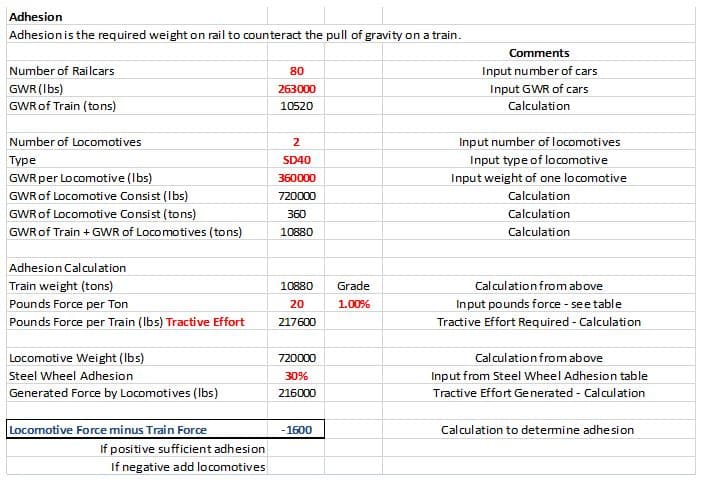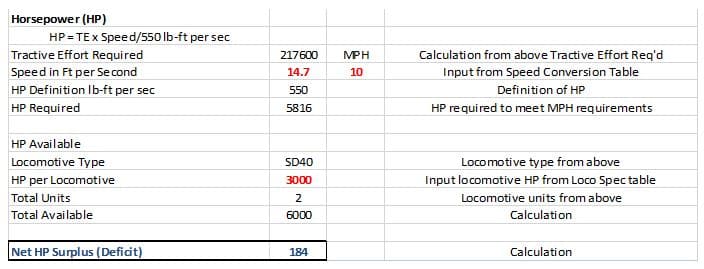It’s important to properly size locomotive requirements to your railcar switching operations requirements. There are a number of factors that either help or impede an industrial switch operation that can be grounded in a basic, simple understanding of the force required to move an anticipated tonnage across a flat or sloped track at various speeds.
Darell Luther
Locomotive sizing for industrial operations is generally more of an art form than science. If you’re getting questions similar to those below it’s probably a good idea to work toward a better understanding of your actual locomotive requirements:
- Why won’t my locomotive consistently pull a string of 20 cars up a simple 1.5 percent grade?
- What on earth is happening to the fuel consumption on my industrial switcher?
- My operations guys continuously burn up rail and I’m sure that equates to being overpowered for my railcar tonnage requirements, doesn’t it?
When you’re in the rail transportation operations business it’s important to properly size locomotive requirements to your railcar switching operations requirements. There are a number of factors that either help or impede an industrial switch operation that can be grounded in a basic, simple understanding of the force required to move an anticipated tonnage across a flat or sloped track at various speeds. Simply put, how many loaded or empty railcars do you need to pull across what slope (ascending or descending) at what speed?
There are a significant number of factors to take into consideration when sizing a locomotive for a switch or industrial operation. These factors specifically need to address:
- Locomotive.What type, horsepower and size do you require for your anticipated operation?
- Force. What is the force or pull on the train as measured by the total gravitational pull on the total tonnage represented by a train, including the weight of the locomotives?
- Tractive Effort. Definitional tractive effort is the force that a locomotive(s) exerts at the rail to move itself and any coupled railcars. Application of tractive effort is specifically at the point a locomotive wheel touches the rail. Tractive effort changes for each throttle position as speed in miles per hour changes.
- Train Drag. Drag on trains consist of flange, wheel-rail interaction, aerodynamic and bearing drag among other resistant factors.
- Grade Resistance. Grade resistance is a key factor in calculating locomotive requirements since the steeper the grade the more resistance resulting in more tractive effort and horsepower requirements.
- Curve Resistance. Curves also impose higher horsepower and tractive effort requirements. Curves in switching operations increase wheel-rail interaction thus increasing train drag.
- Acceleration and Speed Requirements. Track layout and structure significantly help or hurt acceleration and speed requirements for industrial switch operations. Generally when you design or take over the operations of an industrial switchyard, you design your work load and timing allocating a certain amount of time to switch “x” amount of railcars. If these acceleration, speed and deceleration assumptions aren’t met you won’t meet your overall operations goals.
Modeling Requirements
To address the complexities of sizing locomotive requirements for industrial switch operations we’ve simplified the process by compiling a very straight forward easy to understand model. It is important to keep in mind that this model only solves for the highest impact criteria of sizing locomotive requirements for a defined operation. There are a number of factors it does not calculate namely human interaction and competence, training and condition of your locomotive(s).
This model solves for:
- Adhesion. Adhesion is a measure of the locomotive weight requirements to counteract the gravitational pull of the combined locomotive and train weight resistance.
- Axle Requirements. Axle requirements is a calculation of the absolute least number of axles (wheels) that you have exerting force on the rail for the tractive effort requirements to move a train. A general rule of thumb is to not exceed 70,000 pounds per axle to negate damage to rail.
- Horsepower Requirements. Horsepower is not only required to break a train free from rest but also determines the speed that train can maintain at a certain grade.
This model does not solve for:
- Curve. Generally, switch operations have minimal curvature thus curvature doesn’t play as significant a role in this situation.
- Specific Drag. Wheel-rail interaction is based on the assumption that brakes are free and not impeding movement, bearings are all operational, wheels are free of defects sufficient to not impede operations, flanges to rail connection is minimal and such items as truck hunting on railcars does not exist in the switch operation.
- Acceleration/Deceleration. Specific acceleration and deceleration parameters are not calculated. Generally, how fast you get up to speed and how fast you reduce your speed is a function of the specific operating conditions, length of track and more specific factors than we’ll address in this article.
Model Scenario
To better demonstrate the Locomotive Sizing for Industrial Operations we’re sharing a real life scenario that we completed for a customer. The scenario parameters were:
- The customer needed to pull 80 cars at a time around a loop track to unload an 80-car train of aggregates and also needed to be sure to have sufficient power to switch various cuts of railcars generally 20 at a time.
- All railcars are loaded to 263,000 lbs. gross weight on rail.
- The ascending grade is 1 percent.
Our first calculation is for adhesion. Using the above inputs and general information tables we get the results shown in Table 1.In this scenario it takes two SD40-2 six-axle locomotives to produce sufficient weight to counteract the gravitational pull at a 1 percent ascending grade on the train (locomotives and railcars) under perfect steel wheel adhesion conditions. Resulting adhesion is within .007 percent of meeting requirements, thus being an acceptable locomotive solution for the adhesion requirements.
Our next calculation is to determine if we meet the minimum axle requirements to negate rail damage under pulling conditions. Table 2 addresses axle requirements for tractive effort.Results of the axle requirements section show that two six-axle locomotives are sufficient to meet minimal axle requirements. This exercise is somewhat iterative with Table 1 in that while solving for adhesion you must also solve for axle requirements.
Table 3 is used to determine horsepower requirements. It’s important to understand that at this point you’ve calculated adhesion which is the counterweight required to provide sufficient locomotive force to counteract gravitational pull of train force at a 1 percent grade under ideal conditions and you’ve determined the minimum amount of axles required and sized the locomotives to not damage rail when you start pulling trains. Now, you need to determine how fast the train needs to move to meet your requirements.
Some fundamental understanding of horsepower (HP) is necessary to best understand the application of this model. HP by definition is equal to Tractive Effort (TE) x Speed divided by 550 lb-ft per second. We’ve calculated TE requirements above and we use a conversion table (table xxx) to change mile-per-hour to feet-per-second. The rest is a simple calculation as depicted in Table 3. The result is that we have sufficient type (six-axle), number, weight and horsepower to pull an 80 car loaded train at 10 miles per hour up a 1 percent grade.
Other External Factors
Modeling locomotive requirements helps convert locomotive sizing from a trial and error approach to a more logical statistical approach. This approach gets you on paper but you still need to take into account external factors such as condition of locomotives, after market locomotive adhesion packages, more advanced locomotive electronic technology, railcar condition and type, track condition and weather conditions. Locomotive operator training and experience also plays a key role in application of your sizing effort.
Darell Luther is president of Forsyth, MT-based Tealinc Ltd., a rail transportation solutions and railcar leasing company. Darell’s career includes positions as president of DTE Rail and DTE Transportation Services Inc., Fieldston Transportation Services LLC, managing director of coal and unit trains for Southern Pacific Railroad and directors’ positions in marketing, fleet management and integrated network management at Burlington Northern Railroad. Darell has more than 24 years of rail, truck, barge and vessel transportation experience concentrated in bulk commodity and containerized shipments. He can be reached at (406) 347-5237 or via e-mail at [email protected].
Table 1
Calculating adhesion requirements.
Table 2
Calculating axle requirements.
Table 3
Calculating horsepower requirements.
Tables courtesy of Tealinc.



